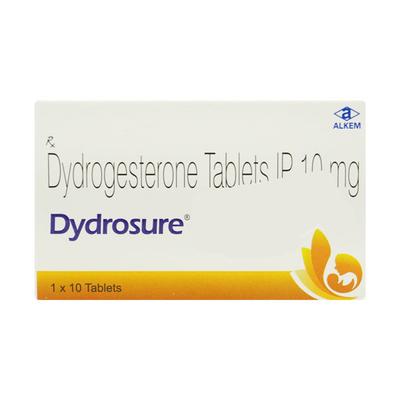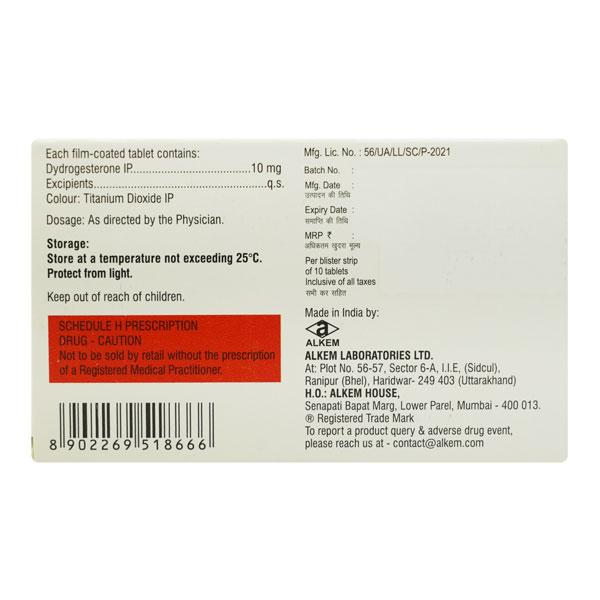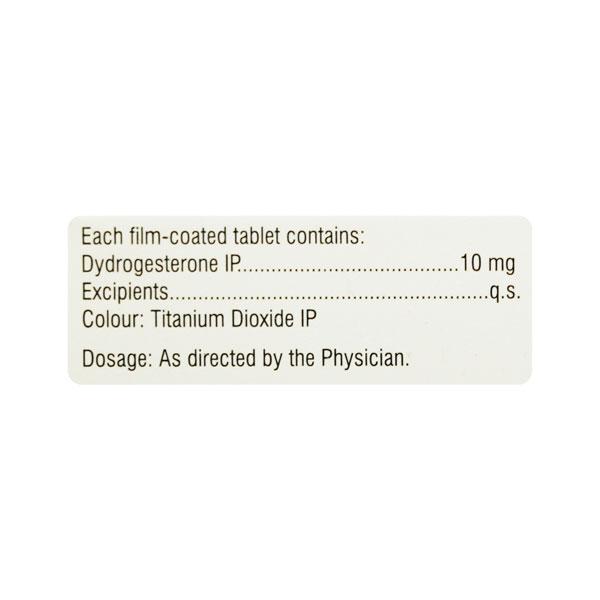

Netmeds First Membership
Quick Links
Introduction About DYDROSURE 10 TABLET
DYDROSURE 10 TABLET contains Dydrogesterone which belongs to the group of medicines called Hormonal Replacement Therapy. It is used to manage progesterone-deficiency states. It helps to manage problems that occur due to a deficiency of a female sex hormone called progesterone in the body. It helps to relieve period cramps and manage symptoms of endometriosis and premenstrual syndrome in women with progesterone deficiency. It can also be used to manage female reproductive health and is used in postmenopausal women to manage signs of menopause when used in combination with estrogens.
Dydrogesterone is a synthetic derivative of a female sex hormone called progesterone. It supplements the bodies with sufficient levels of progesterone. As a result, it relieves the unpleasant symptoms associated with progesterone deficiencies, such as menstrual pain, premenstrual syndrome, infertility, irregular periods, or signs of menopause. During management with DYDROSURE 10 TABLET, your doctor will instruct you to have periodic blood tests and regular physical examinations to avoid the risk of unwanted side effects.
Do not take DYDROSURE 10 TABLET if you have any tumours in the body that is worsened by progesterone (meningioma). Before taking DYDROSURE 10 TABLET inform your doctor if you have any liver problems, depression, or porphyria. Consult your doctor before taking DYDROSURE 10 TABLET if you are pregnant or breastfeeding. DYDROSURE 10 TABLET should be used with caution in adolescent girls who have attained puberty (aged between 12-18 years).
Inform your doctor if you experience any changes in the breast, such as breast pain, tenderness, discharge from the nipple, lump growth in the breasts, heavy menstrual bleeding, pain, swelling, redness of the legs, sudden chest pain, or difficulty breathing after taking DYDROSURE 10 TABLET. The most common side effects of taking DYDROSURE 10 TABLET are severe headaches, nausea, breast pain or tenderness, and painful, heavy, or irregular periods. Consult your doctor if any of these side effects worsen.
Uses Of DYDROSURE 10 TABLET
It is used to:
- relieve menstrual pain
- manage the symptoms of endometriosis and premenstrual syndrome
- manage female reproductive health
How DYDROSURE 10 TABLET Works
DYDROSURE 10 TABLET helps in managing problems associated with progesterone deficiency states. It improves the thickness of the uterine lining, which helps in correcting infertility problems and irregular periods. It also provides relief from postmenopausal symptoms (such as hot flushes, sleep problems, irritability, and depression) by replacing the deficient progesterone levels in the body.
How to use DYDROSURE 10 TABLET
Take DYDROSURE 10 TABLET as advised by your physician. Swallow DYDROSURE 10 TABLET with a glass of water. Do not crush or chew the medicine. Try to take DYDROSURE 10 TABLET at the same time each day. It can be taken with or without food. Your doctor will decide the correct dose and duration of DYDROSURE 10 TABLET for you depending upon your age, body weight, and disease condition.
Side Effects Of DYDROSURE 10 TABLET
Common
- headache
- migraine
- nausea
- breast pain or tenderness
- painful, heavy, or irregular periods
- lack of periods
Uncommon
- weight gain
- skin rash, redness, or itching
- depression
- dizziness
- vomiting
Rare
- low levels of red blood cells (hemolytic anemia)
- hypersensitivity reactions such as sneezing, itchy, runny, or blocked nose, red, or watering eyes
- fluid retention
- swelling of the breasts
- sleepiness
- increase in the size of tumors affected by progestogens such as meningioma
- worsening of porphyria
Stop taking DYDROSURE 10 TABLET and contact your doctor if you experience any of the following side effects:
- signs of angioedema (such as swelling of the skin around the face and throat, which may cause difficulty breathing)
- signs of liver problems (yellowing of the skin or eyes, feeling generally unwell with stomach pain)
- signs of allergic reactions (such as difficulty breathing or reactions involving the whole body such as nausea, vomiting, diarrhea, or low blood pressure)
- signs of a blood clot (such as pain and swelling in the legs, sudden chest pain, or difficulty breathing)
- sign of a heart attack (such as chest pain that spreads to your arm or neck)
- stroke or severe, unexplained headache or migraine (with or without vision problems)
- signs of breast cancer (breast pain or tenderness, swollen breasts, discharge from the nipples and changes in breast tissue)
How To Manage Side Effects
Diarrhea
Try to rest and relax. Get enough sleep. Avoid driving or operating any tools or machines completely while you are feeling dizzy. Do not consume excessive alcohol, as it could aggravate your dizziness. Consult your doctor if your dizziness worsens.
Headache
Rest and relax. Keep yourself hydrated by drinking plenty of fluids, such as water or electrolytes. Applying a pain-relieving balm to your forehead can be beneficial. Do not consume excessive alcohol, as it could aggravate your headache. Consult your doctor if your headache worsens.
Nausea And Vomiting
Take DYDROSURE 10 TABLET with or just after meals. Stick to simple meals. Avoid eating oil-rich or spicy foods. Consult your doctor if your nausea worsens.
Warning & Precautions
Pregnancy
Monitoring requiredDYDROSURE 10 TABLET should be used in pregnant women only if it is considered necessary by the physician. Therefore, inform your doctor before taking DYDROSURE 10 TABLET if you are pregnant, think you may be pregnant, or are planning to have a baby.
Breastfeeding
ContraindicatedDYDROSURE 10 TABLET is not recommended for use in breastfeeding women. However, consult your doctor before taking the medicine.
Driving and Using Machines
Use with CautionDo not drive or handle heavy machines if you experience dizziness after taking DYDROSURE 10 TABLET.
Alcohol
Consult your doctorAvoid consumption of alcohol while taking DYDROSURE 10 TABLET, as it may increase the risk of side effects.
Kidney
Use with CautionDYDROSURE 10 TABLET should be used with caution in patients with kidney problems. Therefore, consult your doctor before taking it.
Liver
Use with CautionDYDROSURE 10 TABLET should be used with caution in patients with liver problems. Therefore, consult your doctor before taking the medicine.
Allergy
ContraindicatedDo not take DYDROSURE 10 TABLET if you are allergic to Dydrogesterone or any other ingredients of this medicine.
Lungs
ContraindicatedDYDROSURE 10 TABLET is not recommended for use in patients with blood clots in their lungs (pulmonary embolism). Therefore, consult your doctor before taking the medicine.
Heart Disease
ContraindicatedDYDROSURE 10 TABLET is not recommended for use in patients with heart diseases. Therefore, consult your doctor before taking it.
Use In Pediatrics
Consult your doctorDYDROSURE 10 TABLET should be used in post pubertal female children (aged between 12-18 years) only if prescribed by the physician. It is not intended for use in male children or in female children who have not attained puberty. Therefore, consult your doctor before taking it.
Use In Geriatrics
Use with CautionDYDROSURE 10 TABLET should be used with caution in elderly patients (aged 65 years or older). Therefore, consult your doctor before taking it.
Others
DYDROSURE 10 TABLET is not recommended for use if you:
- have a tumor that is worsened by progestogens (such as meningioma)
- have irregular or unusually heavy periods
Before taking DYDROSURE 10 TABLET, inform your doctor if you:
- have unexpected vaginal bleeding or spotting
- have depression
- have porphyria (a rare inherited blood disorder)
- are planning for hormone replacement therapy
- have early menopause (less than 6 months from the last periods)
- have blood clots in your body
- have any type of cancer
- are overweight
- are staying bed-ridden for a long time
- have or ever had systemic lupus erythematosus (a serious disease in which the immune system attacks its own body)
- are going to have surgery, a blood test, or a urine test
Interactions
A. Drug-Drug Interactions:
Before taking DYDROSURE 10 TABLET, inform your doctor, if you are taking any of the following medicines, such as:
- medicines used to manage epilepsy (Ex. phenobarbital, phenytoin, and carbamazepine)
- medicines used to manage tuberculosis (Ex. rifampicin, rifabutin)
- medicine used to manage HIV infection (Ex. nevirapine, efavirenz, ritonavir, and nelfinavir)
- John’s wort (an herbal medicine used to manage depression)
- Other herbal medicines (such as sage or ginkgo biloba)
Overdosage:
If you or anyone else accidentally took more of DYDROSURE 10 TABLET, consult your doctor immediately or visit the nearby hospital. Symptoms of overdosage might include nausea, sleepiness, dizziness, or vomiting.
Synopsis
| Drug | : | Dydrogesterone |
| Pharmacological Category | : | Progesterone derivative |
| Therapeutic Indication | : | Progesterone deficiency states |
| Dosage Forms | : | Tablet |
More Information
Storage
- Keep DYDROSURE 10 TABLET out of reach of children
- Store DYDROSURE 10 TABLET at room temperature
FAQs About DYDROSURE 10 TABLET
Q: What DYDROSURE 10 TABLET is used for?
A: DYDROSURE 10 TABLET is a hormonal therapy used to manage progesterone deficiency states. It can relieve period cramps and can manage symptoms of endometriosis and premenstrual syndrome.
Q: How to take DYDROSURE 10 TABLET?
A: Take DYDROSURE 10 TABLET as advised by your physician. Swallow DYDROSURE 10 TABLET with a glass of water and do not chew or crush the medicine. Try to take DYDROSURE 10 TABLET at the same time each day. It can be taken with or without food. Do not miss any dose of DYDROSURE 10 TABLET in between the therapy, as it may reduce its effectiveness.
Q: What are the side effects of DYDROSURE 10 TABLET?
A: The most common side effects of taking DYDROSURE 10 TABLET are severe headache, nausea, breast pain or tenderness, and painful, heavy, or irregular periods. Consult your doctor if any of these side effects worsen. Inform your doctor if you experience any changes in breast such as breast pain, tenderness, discharge from the nipple, or lump growth in the breasts, heavy menstrual bleeding, pain, swelling, redness of the legs, sudden chest pain, or difficulty breathing after taking DYDROSURE 10 TABLET.
Q: Can I stop taking DYDROSURE 10 TABLET once my symptoms subside?
A: No. Do not stop taking DYDROSURE 10 TABLET unless your doctor advises you to stop, because sudden termination of DYDROSURE 10 TABLET will not provide an expected result. Continue to take DYDROSURE 10 TABLET as advised by your doctor to achieve maximum benefits.
Q: How long does bleeding cause while taking DYDROSURE 10 TABLET?
A: Nearly 75-90% of women experience bleeding up to 5 days while undergoing therapy with DYDROSURE 10 TABLET. Bleeding usually starts on the last day of the monthly course or may happen in between the cycles as well. However, consult your doctor if you are bleeding or spotting appears after some time on therapy or continues to happen even after stopping taking DYDROSURE 10 TABLET.
Q: What happens if I forget to take DYDROSURE 10 TABLET?
A: If you forget to take a dose of DYDROSURE 10 TABLET and if it is less than 12 hours since you forgot, take it as soon as you remember. However, if it is more than 12 hours or time for the next dose, skip the missed dose and take the next dose of DYDROSURE 10 TABLET at regular time. Do not take a double dose of DYDROSURE 10 TABLET to compensate for the missed dose.
Q: Is DYDROSURE 10 TABLET safe to use in children?
A: DYDROSURE 10 TABLET should be used in postpubertal female children (aged between 12 and 18 years) only if prescribed by the physician. It is not intended for use in male children or in female children who have not attained puberty. Therefore, consult your doctor before taking it.
Q: How do I order DYDROSURE 10 TABLET from Netmeds?
A: If you wish to buy DYDROSURE 10 TABLET on Netmeds, you need a prescription from a registered medical practitioner. You can visit the website, search for the product, add it to your cart, and proceed with the checkout process. Netmeds has made buying online medicines easier for consumers and is one of India's leading online pharmacies.
Q: What should I avoid while taking DYDROSURE 10 TABLET?
A: Avoid consumption of alcohol while taking DYDROSURE 10 TABLET, as it may increase the risk of side effects.
Q: Who should avoid taking DYDROSURE 10 TABLET?
A: DYDROSURE 10 TABLET is not recommended for use if you have a tumor that is worsened by progestogens (such as meningioma), have irregular or unusually heavy periods, blood clots in their lungs (pulmonary embolism), heart diseases, or are allergic to Dydrogesterone. Therefore, consult your doctor before taking the medicine.
Q: What precautions must be taken while using DYDROSURE 10 TABLET?
A: Before taking DYDROSURE 10 TABLET, inform your doctor if you have kidney and liver problems, unexpected vaginal bleeding or spotting, depression, porphyria (a rare inherited blood disorder), or are planning for hormone replacement therapy, have early menopause, blood clots in your body, have any type of cancer, or are overweight, staying bed-ridden for a long time, have or ever had systemic lupus erythematosus, or are going to have surgery, a blood test, or a urine test.
References
1. KD. Tripathi. Estrogens, Progestins and Contraceptives. Essentials of Medical Pharmacology. Seventh Edition. 2013. Page – 316.
2. Dydrogesterone. NIH National Library of Medicine, National center for biotechnology information. PubChem. June 2022 [Accessed on 30th August 2024] https://pubchem.ncbi.nlm.nih.gov/compound/Dydrogesterone#section=Biological-Half-Life
3. Abbott Biologicals BV. Health Products Regulatory Authority (HPRA). [Revised in August 2021] [Accessed on 30th August 2024] http://www.hpra.ie/img/uploaded/swedocuments/aa13b2c3-1e2e-48c2-b843-b9a201a754d4.pdf
4. Abbott Laboratories S.A. (Pty) Ltd. South African Health Products Regulatory Authority (SAHPRA). [Revised in April 2012] [Accessed on 30th August 2024] https://www.sahpra.org.za/wp-content/uploads/2020/08/Duphaston_PI_Abbott_MCC-Format20-April-2012.pdf
Useful Diagnostic Tests
- Anti Mullerian Hormone (AMH)/Mullerian Inhibiting Substance – ELISA
- Follicle Stimulating Hormone (Fsh)
- Complete Blood Count (CBC)/ Hemogram
- HbA1C, Also known as Glycated Hemoglobin, Glycosylated Hemoglobin
- Thyroid Stimulating Hormone
- Testosterone
- Testosterone Free










